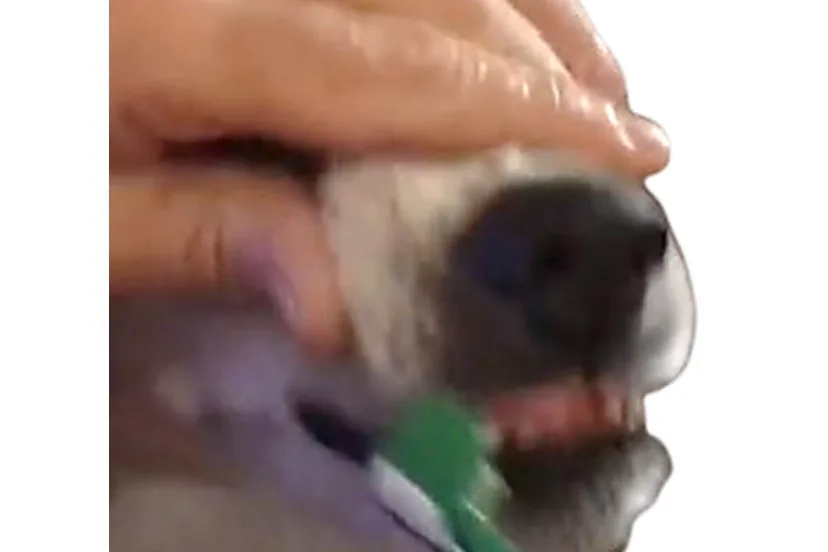Dog Toothbrush Guide: Unlocking Canine Health Thru Brushing
Being a devoted advocate and passionate caregiver for my beloved four-legged friend, I understand the importance of maintaining their overall health and well-being. One aspect of canine care that often gets overlooked is dental hygiene. Just like humans, dogs require regular dental care, like tooth brushing, to prevent oral health issues such as gum disease, tartar buildup, and bad breath. In this article, I’ll share insights into what to look for in a dog toothbrush to ensure your canine companion’s teeth stay clean and healthy.
Why Dental Care Matters for Our Dogs
Did you know February is National Pet Dental Health Month? Sponsored by the American Veterinary Medical Association, it’s all about helping pet parents like us improve our furry friends’ dental and overall health. Studies even suggest that a healthy mouth can add years to our pets’ lives!
Proper dental care is vital for our dogs to maintain good overall health. Poor dental hygiene can lead to various health issues, including periodontal disease, tooth loss, and even systemic health problems like heart disease and kidney issues. By incorporating regular dental care into your dog’s routine, you can help prevent these issues and ensure your furry friend enjoys a happy and healthy life.
Sadly, over 80% of dogs develop gum disease by age three. So, it’s crucial to know how to care for their teeth to keep them healthy and happy. But what exactly is gum disease?
Gum disease, characterized by swelling, soreness, or infection of the tissues supporting the teeth, comes in two main forms: gingivitis and periodontal disease. Let’s break them down.
Gingivitis, which means ‘inflammation of the gums,’ occurs when the gums around the teeth become red and swollen. They may even bleed during brushing.
If left untreated, gingivitis can progress into periodontal disease, affecting the tissues supporting the teeth. Eventually, the bone anchoring the teeth can be lost, leading to loose teeth or even tooth loss.
What’s the culprit behind gum disease? Plaque! It’s a film of bacteria that forms on the teeth daily. While most bacteria in plaque are harmless, some are responsible for gum disease.
To prevent and treat gum disease, it’s essential to remove all plaque from your dog’s teeth daily. Regular brushing can help keep their teeth clean and healthy. Creating a consistent routine, even if it’s not daily, can significantly reduce plaque and tartar buildup.
Understanding Dog Toothbrushes
When it comes to a dog toothbrush, not all are created equal. There are several types available, including traditional toothbrushes, fingerbrushes, and even toothbrush toys. Each type serves a different purpose and may be more suitable for certain dogs depending on their size, temperament, and dental health needs. It’s essential to choose the right dog toothbrush to make the brushing experience as positive, comfortable and effective as possible for your dog.
Key Features to Look for in a Dog Toothbrush
When selecting a dog toothbrush, there are several key features to consider:
-
Size and Shape of the Brush Head:
The brush head should be appropriately sized for your dog’s mouth, allowing you to reach all teeth comfortably.
-
Bristle Type and Softness:
Ensure the dog toothbrush you choose is soft and pliable. This is crucial when introducing your dog to toothbrushing to avoid causing discomfort or bleeding to their gums. Most common dog toothbrushes feature nylon bristles, which are ideal for reaching under the gumline. A silicone finger dog toothbrush offers gentle massages to the gums.
-
Handle Design for Easy Grip:
Look for a dog toothbrush with a nonslip handle for better control while brushing your dog’s teeth. Rubber-coated or curved handles provide improved grip. Consider the handle length as well, ensuring it’s easy to maneuver during brushing sessions.
It’s best to use a toothbrush specifically made for dogs, never use a human toothbrush. Dog toothbrushes are smaller and have flexible softer bristles.
Choosing the Right Toothbrush for Your Dog
When choosing a toothbrush for your dog, it’s essential to consider your dog’s individual needs and preferences. Factors such as your dog’s size, breed, and temperament can all influence which toothbrush will be most suitable. A finger dog toothbrush is specifically designed for smaller dogs and many pet parents find this style more convenient to use. Avoid using a finger dog toothbrush with a dog you don’t trust to prevent any risk of biting.
Getting a recommendation from your veterinarian can help ensure you select the best toothbrush for your doggie.
Tips for Using a Dog Toothbrush Effectively
Introducing your dog to a toothbrush may take some time and patience, especially if they’re not accustomed to having their teeth brushed. Here are some tips for making the brushing experience more comfortable and effective for both you and your dog:
-
Introduce the Toothbrush Gradually:
Start by allowing your dog to sniff and lick the toothbrush to familiarize themselves with it before attempting to brush.
-
Establish a Routine:
Set aside a specific time each day for brushing your dog’s teeth to establish a routine and make it a regular part of their care regimen.
-
Use Positive Reinforcement:
Reward your dog with praise, treats, or their favorite toy after each brushing session to associate the experience with something positive.
How to Start Introducing a Dog Toothbrush
Before actually brushing your dog’s teeth, it’s crucial to help them get used to having their mouth handled. While some dogs may readily accept it, others might require deliberate effort and patience.
Approaching Their Mouth
Start with gentle caresses of the outside of your dog’s muzzle and mouth while offering praise and rewards. The goal is to ensure your dog feels comfortable with mouth handling. While some dogs may be accustomed to this, others may be less so. If your dog appears uneasy with your hand near their mouth, extend your hand out for them to investigate, praising and rewarding their curiosity. This approach allows your dog to initiate contact, minimizing discomfort. Persist until your dog eagerly approaches your hand and permits mouth contact without hesitation.
Exploring the Inside of Their Mouth
Once your dog is at ease with exterior mouth contact, advance to exploring the inside. Begin by delicately lifting your dog’s lip, praising and rewarding their cooperation. Maintain a gentle and enthusiastic manner to encourage your dog’s engagement. While touching the mouth, experiment with lifting various sections of the lips, consistently praising and treating your dog throughout.
Exploring the Teeth
Following several sessions of lip lifting, proceed to touch your dog’s teeth with your finger, offering praise and treats. Positive reinforcement works wonders to reassure your dog that they are safe and this is a desired behavior. Explore the front, side, and back teeth. For some dogs, this sensation may feel strange, while others may be entirely unfazed by it. Once your dog is at ease with your finger movements and mouth manipulation, they are ready for you to introduce a dog toothbrush.
Introducing a Dog Toothbrush
- Allow your dog to investigate the dog toothbrush in your hand and reward any interest shown.
- Apply toothpaste to the brush and encourage your dog’s curiosity by praising any interaction. This could include sniffing or licking the dog toothbrush or dog toothpaste.
- Lift your dog’s lip, touch a tooth’s outer surface with the dog toothbrush, and reward positive responses.
- Repeat the process of lip lifting and tooth touching with the dog toothbrush as before.
- Progress to gently brushing all areas of your dog’s mouth, rewarding cooperation.
- Practice regularly until you can thoroughly brush your dog’s entire mouth and gum line.
If your dog shows any signs of discomfort or resistance during toothbrushing, return to a previous step where they felt at ease. Spend a few sessions there before progressing. Once your dog is comfortable with the dog toothbrush, make it part of their routine. Regular brushing prevents tartar and plaque buildup. Some brushing is better than none. Like with our own oral care, aim for daily brushing sessions when possible.
Dog Toothpaste
Only use dog toothpaste, which is specially formulated to be safe for pets when swallowed. Never use human toothpaste, as it often contains ingredients that could be harmful to dogs. Some human toothpaste contains xylitol, which is toxic to dogs.
Other Dental Care Products and Practices
In addition to regular brushing, there are other dental care products and practices that can help maintain your dog’s oral health:
-
Dental Chews and Toys:
Chewing on dental chews or toys can help reduce plaque and tartar buildup while providing mental stimulation for your dog.
-
Professional Dental Cleanings:
Regular professional cleanings by a veterinarian are essential for removing stubborn tartar and addressing any underlying dental issues.
-
Dietary Considerations:
Certain foods and treats are formulated to promote dental health by reducing plaque and tartar buildup. Look for products approved by veterinary dental associations for optimal effectiveness.
Conclusion
In conclusion, investing in a quality dog toothbrush and incorporating regular dental care into your dog’s routine is essential for maintaining their oral health and overall well-being. By choosing the right toothbrush, establishing a brushing routine, and using positive reinforcement techniques, you can help keep your canine companion’s teeth clean and healthy for years to come.
FAQs:
Q1.: Why is dental care important for dogs?
A: Dental care is crucial for dogs to prevent oral health issues such as gum disease, tartar buildup, and bad breath.
Q2.: How do I choose the right toothbrush for my dog?
A: Consider your dog’s size, breed, and temperament, and look for a dog toothbrush with soft, flexible bristles and an ergonomic handle.
Q3. How often should I brush my dog’s teeth?
A: Aim to brush your dog’s teeth at least three times a week, if not daily, to maintain good oral hygiene.
Q4.: Can I use human toothpaste on my dog?
A: No, human toothpaste contains ingredients that can be harmful to dogs if swallowed. Use toothpaste specifically formulated for pets.
Q5.: What if my dog doesn’t like having their teeth brushed?
A: Be patient and gradually introduce the dog toothbrush, using positive reinforcement techniques to make the experience more enjoyable for your dog.




